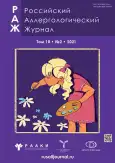Challenges of differential diagnosis of mediators-induced and bradykinin-induced angioedema shown by a clinical case series
- Authors: Manto I.A.1, Latysheva E.A.1, Timoshenko D.O.2, Latysheva T.V.1,3
-
Affiliations:
- National Research Center – Institute of Immunology Federal Medical-Biological Agency of Russia
- Pirogov Russian National Research Medical University (Pirogov Medical University)
- Moscow State University of Medicine and Dentistry named after A.I. Evdokimov
- Issue: Vol 18, No 2 (2021)
- Pages: 131-137
- Section: Case reports
- URL: https://journals.rcsi.science/raj/article/view/121783
- DOI: https://doi.org/10.36691/RJA1453
- ID: 121783
Cite item
Full Text
Abstract
Angioedema is caused by a local increase in vascular permeability induced by bradykinin or mast cell mediators. The main challenge of the differential diagnosis of angioedema lies in the fact that different pathophysiological processes may lead to a very similar clinical picture. Moreover, verification of the type of angioedema is crucial for selection of appropriate therapy. In 2020, a school for doctors “Chronic urticaria: scientific and medical accomplishments and practical aspects of patient management” was held on the basis of the National Research Center Institute of Immunology of the FMBA of Russia as part of the work of the reference center that provides expert assistance to patients with urticaria (GA²LEN UCARE). A clinical case series of related patients with hereditary angioedema due to a mutation in the PLG gene was presented to demonstrate the challenges of the differential diagnosis between types of angioedema. This article focused on the description of this series.
Keywords
Full Text
##article.viewOnOriginalSite##About the authors
Irina A. Manto
National Research Center – Institute of Immunology Federal Medical-Biological Agency of Russia
Email: irina.manto@yandex.ru
ORCID iD: 0000-0001-6432-394X
SPIN-code: 7944-5159
MD, Research Associate
Russian Federation, 24, Kashirskoye shosse, Moscow, 115522Elena A. Latysheva
National Research Center – Institute of Immunology Federal Medical-Biological Agency of Russia
Email: ealat@mail.ru
ORCID iD: 0000-0002-1606-205X
SPIN-code: 2063-7973
MD, Dr. Sci. (Med.), Senior Research Associate
Russian Federation, 24, Kashirskoye shosse, Moscow, 115522Daria O. Timoshenko
Pirogov Russian National Research Medical University (Pirogov Medical University)
Author for correspondence.
Email: d.o.timoshenko@gmail.com
ORCID iD: 0000-0002-7585-1390
SPIN-code: 2714-0906
Russian Federation, 1, Ostrovityanova, Moscow,117997
Tatiana V. Latysheva
National Research Center – Institute of Immunology Federal Medical-Biological Agency of Russia; Moscow State University of Medicine and Dentistry named after A.I. Evdokimov
Email: tvlat@mail.ru
ORCID iD: 0000-0003-1508-0640
SPIN-code: 8929-7644
MD, Dr. Sci. (Med.), Professor
Russian Federation, 24, Kashirskoye shosse, Moscow, 115522; 20, building 1, Delegatskaya str., Moscow, 127473References
- Depetri F., Tedeschi A., Cugno M. Angioedema and emergency medicine: From pathophysiology to diagnosis and treatment // Eur J Intern Med Elsevier. 2019. Vol. 59. Р. 8–13. doi: 10.1016/j.ejim.2018.09.004
- Maurer M., Magerl M. Differences and Similarities in the mechanisms and clinical expression of bradykinin-mediated vs. mast cell–mediated angioedema // Clin Rev Allergy Immunol. 2021. doi: 10.1007/s12016-021-08841-w
- Obtułowicz K. Bradykinin-mediated angioedema // Pol Arch Med Wewn. 2016. Vol. 126, N 1-2. Р. 76–85. doi: 10.20452/pamw.3273
- Cicardi M., Suffritti C., Perego F., Caccia S. Novelties in the diagnosis and treatment of angioedema // J Investig Allergol Clin Immunol. 2016. Vol. 26, N 4. Р. 212–221. doi: 10.18176/jiaci.0087
- Zuraw B.L., Christiansen S.C. HAE pathophysiology and underlying mechanisms // Clin Rev Allergy Immunol. 2016. Vol. 51, N 2. Р. 216–229. doi: 10.1007/s12016-016-8561-8
- Maurer M., Magerl M., Ansotegui I., et al. The international WAO/EAACI guideline for the management of hereditary angioedema – the 2017 revision and update / World Allergy Organ J. 2018. Vol. 11, N 1. Р. 1–20. doi: 10.1186/s40413-017-0180-1
- Союз педиатров России и др. Наследственный ангиоотёк. Клинические рекомендации (D84.1). 2020. Режим доступа: https://www.pediatr-russia.ru/information/klin-rek/deystvuyushchie-klinicheskie-rekomendatsii/%D0%9D%D0%B0%D1%81%D0%BB%D0%B5%D0%B4%D1%81%D1%82%D0%B2%D0%B5%D0%BD%D0%BD%D1%8B%D0%B9%20%D0%B0%D0%BD%D0%B3%D0%B8%D0%BE%D0%BE%D1%82%D0%B5%D0%BA_2020.pdf. Дата обращения: 03.02.2021.
- Bork K., Machnig T., Wulff K., et al. Clinical features of genetically characterized types of hereditary angioedema with normal C1 inhibitor: a systematic review of qualitative evidence // Orphanet J Rare Dis. 2020. Vol. 15, N 1. Р. 1–14. doi: 10.1186/s13023-020-01570-x
- Bork K., Wulff K., Steinmüller-Magin L., et al. Hereditary angioedema with a mutation in the plasminogen gene // Allergy Eur J Allergy Clin Immunol. 2018. Vol. 73, N 2. Р. 442–450. doi: 10.1111/all.13270
- Banday A.Z., Kaur A., Jindal A.K., et al. An update on the genetics and pathogenesis of hereditary angioedema // Genes Dis Elsevier Ltd. 2020. Vol. 7, N 1. Р. 75–83. doi: 10.1016/j.gendis.2019.07.002
- Bodian D.L., Vilboux T., Hauser N.S. Genotype-first analysis of a generally healthy population cohort supports genetic testing for diagnosis of hereditary angioedema of unknown cause // Allergy Asthma Clin Immunol BioMed Central. 2019. Vol. 15, N 1. Р. 1–4. doi: 10.1186/s13223-019-0346-1.
Supplementary files







